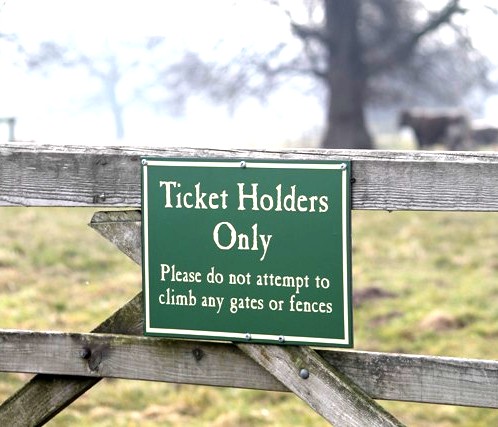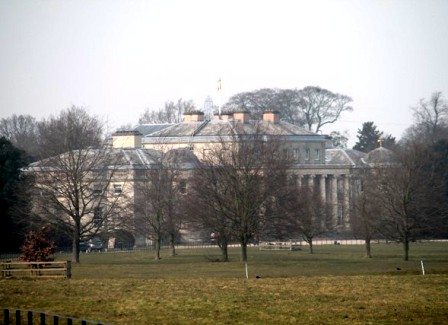
The public view of a national asset
Making stately progress in Staffs
What with an early Easter and a late spring, the keepers of countryside attractions will have welcomed recent breaks in the weather. Mick Owen went for a nice day out in the country and drew some surprising inferences.

The public view of a national asset
Viewed from the road the village of Great Heywood in Staffordshire is unremarkable and soon despatched into the rear view mirror with little regret . However, for canal users and frequenters of stately homes – and the two are not necessarily discrete sets – the name is redolent. For the former, the junction of the Trent and Mersey, and the Staffordshire and Worcestershire canals is a key pinch point on “the system” with a marina, a hire boat centre, water and rubbish points, and ample moorings, both permanent and transitory, making it a honey-pot for boaters and gongoozlers alike. For the latter – those appreciating the architecture – it is the grace of Shugborough Hall, the West Midlands’ answer to Blenheim Palace, which draws the crowds.
In the week when Margaret Thatcher had gone to upbraid her maker and with snow still lying where it had been piled by National Trust staff, The Leisure Review took a turn around the environs of Great Heywood and wondered what the future holds for places like Shugborough and its less glamorous neighbours. That we chose to travel by narrowboat, a mode of transport originally exclusively utilitarian but now whose use is as riven with class distinction as society itself [ see TLR passim] , may have influenced what we saw when we looked at the 300- year-old edifice.
The best way to approach Great Heywood is from the south and by canal. Not only will this enable you to see the panoply of Shugborough Hall gently emerging from its bucolic surrounds like a monstrous Cabbage White but, having only recently left the dreariness of a town called Rugeley which, squatting beneath the massed towers of its eponymous power station, is an archetype of depressed and depressing semi-urban semi-living, you will be better able to appreciate the glory of the building that has been home to the likes of Patrick Lichfield, titled snapper to the crown. Only in England could a town which speaks of dull parsimony be juxtaposed with a building which shouts so loudly of patrician excess and nobody complain.
Once you have paid your licence fee to the Canal and River Trust, the body which took over the management of Britain’s waterways last year, you are free to moor almost anywhere on a canal and in Great Heywood that means you can metaphorically drop anchor so that the view from your cratch – the bit at the front – is filled with Cannock Chase, the River Trent, its wide, flat, bucolic valley and the big house itself. With the late afternoon sun giving everything a suitably rosy glow it is almost possible to turn off your egalitarian sensibilities and enjoy it but gather your travelling companions about you and wander towards the great house and they will soon bristle back into place.
As you approach the tiny lock that sits below the junction of the two canals you pass under an unremarkable iron bridge built by the denizens of the hall, the moneyed family Anson , to cross both river and canal ; it is wide enough to take a carriage. The bridge was required so that “the family” did not have “to walk the 300 yards to church on Sunday mornings”. We are indebted to Nicholson’s Waterways Guide Number 4 for this information as we are for the notes which tell us that the rather quaint cottages between the canal and the excellent Clifford Arms public house were “built by the Ansons to house the people evicted from the former Shugborough village” to accommodate either the Arch of Hadrian (built to commemorate something naval), the re-routing of the River Sow (to improve the view from the house) or the re-routing of the main road (to afford the Ansons more privacy), depending on what you read.
The route from Heywood Lock towards the big house crosses the confluence of the Sow and the Trent on a packhorse bridge built in 1550 by “the then Earl of Sussex, a favourite of Queen Elizabeth I”. The Wikipedia entry we quote does not join the dots but local legend has it that the bridge’s sole purpose was to facilitate some clandestine, high- end trysting. Whatever its genesis, the bridge is charming, which is more than can be said for the signage which begins almost as soon as the river’s somnolent gurgle has completely receded. Although no survey was carried out, it is this correspondent’s contention that the most used letters in Shugborough Hall’s sign-writing department are ‘ N’ , ‘ O’ and ‘ T’ .
Quite simply, unless you pay through the nose you stay on the footpath and while you are on the footpath watch out for the Italian train which scoots the proper people – the ones who have paid – to various points of the Shugborough compass, such as the mansion house, the walled garden or the Georgian farm and mill. The poor man – and the niggard – must content himself with the view afforded from beyond a fence which not even a springer spaniel on a mission could broach. You can still behold the mansion’s impressive frontage, still peek into parts of the farm and still discern various of the eight follies that some foppish former resident felt fit to have built but the whiff of noblesse oblige is acrid, especially given the fact that the building is leased by Staffordshire County Council and, for all the work of the National Trust (NT) with its middle- class, middle- England membership, it is only not falling down or being used to run management seminars because of local authority support.
It may be inaccurate to characterise NT Man as a devotee of the recently deceased former prime minister but if the car park and the foot traffic on offer was anything to go by there was a Daily Mail in every motor and a mindset more at home in the days of the Raj than in 21st-century Tooting Bec. Thatcher declared that there was no such thing as society and then set about achieving that end. Had the woman cruelly satirised by certain record buyers as an evil witch miraculously passed through Shugborough on the day we visited the Mexican wave of bobbed curtsies and doffed, faux-Tweed caps would have rippled like nearby Tixall Wide brushed by an afternoon zephyr.
Much can be said for the heritage industry but little for a Disney-tisation of the nation’s assets which reduces national treasures to brands, airbrushes unsightly history out of guide books and is accessible only by those with significant disposable income. When taken as a whole in its social as well as geographical context no critical comment is required other than to note that Margaret Thatcher would have loved it.
Mick Owen is the managing editor of The Leisure Review and occasional captain of the Good Ship Symphony
The Leisure Review, May 2013
© Copyright of all material on this site is retained by The Leisure Review or the individual contributors where stated. Contact The Leisure Review for details.
![]() Download a pdf version of this article for printing
Download a pdf version of this article for printing
